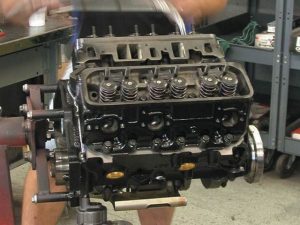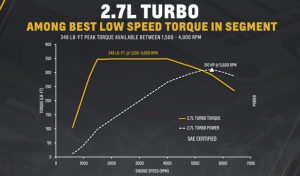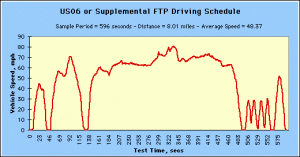Guest Post by Eric Peters

Trucks continue to get bigger – what buyers seem to want – while their engines get smaller, which is effectively a function of what the government demands, as the downsizing of engines is one of the ways for the car companies to reduce the fuel consumption of the vehicles so equipped.
Which they have to do – not because buyers of trucks (or even most cars) are demanding fuel economy uber alles but because the government refuses to accept that lots of buyers care about other things uber alles. So the government mandates the fuel economy they’re not particularly interested in, in order to force buyers to be more “efficient” – no matter what it costs them.
And the car companies try to figure a way to make those smaller, more “efficient” engines perform at a level acceptable to buyers.
Enter the 2019 Chevy Silverado 1500 – the leading edge of this strange, increasingly desperate dynamic. It will be the first full-size truck to come standard with a four cylinder engine – comparable in size (2.7 liters) to the engines that power mid-sized cars that weigh 1,000-plus pounds less and which aren’t tasked with towing thousands of pounds.
It is my sincere desire to provide readers of this site with the best unbiased information available, and a forum where it can be discussed openly, as our Founders intended. But it is not easy nor inexpensive to do so, especially when those who wish to prevent us from making the truth known, attack us without mercy on all fronts on a daily basis. So each time you visit the site, I would ask that you consider the value that you receive and have received from The Burning Platform and the community of which you are a vital part. I can't do it all alone, and I need your help and support to keep it alive. Please consider contributing an amount commensurate to the value that you receive from this site and community, or even by becoming a sustaining supporter through periodic contributions. [Burning Platform LLC - PO Box 1520 Kulpsville, PA 19443] or Paypal
-----------------------------------------------------
To donate via Stripe, click here.
-----------------------------------------------------
Use promo code ILMF2, and save up to 66% on all MyPillow purchases. (The Burning Platform benefits when you use this promo code.)
The little engine replaces the 4.3 liter V6 that is the current Silverado’s standard engine and makes up for its lack of displacement via heavy turbocharging – which adds power-on-demand but also adds parts and internal stress as well as costs, both up front and down the road.
Probably just after the warranty expires.
As opposed to the 4.3 V6, which doesn’t need a turbo to make power and is a much simpler, lower-maintenance design. It is basically a Chevy small-block V8 less two cylinders. It shares the famous – and famously simple – layout that made its debut back in 1955. A very proven – and very durable – design.
One camshaft, not mounted over the heads. Two valves in those heads. A timing chain that never needs to be replaced instead of a belt that periodically does. And, of course, no turbo. So, no worries about having to replace a turbo after the warranty runs out. Ever.
Not even after 250,000 miles. Regular vs. premium unleaded fuel.
The 2.7 liter engine is turbocharged and intercooled and double overhead cammed, with twice as many valves in its head. It makes 310 hp vs. 285 hp for the force-retired V6, but it takes 22 pounds of boost (and premium unleaded) to do it. That is a lot of pressure on an engine. Maybe it will hold up. Maybe not.
If not, who gets the bill?
A replacement turbo will generally cost you $800-$1,500 in parts and labor. How much gas did you save, again?
Naturally, the car press doesn’t mention any of that – nor that the fuel economy gains will probably be trivial vs. the simpler, lower-cost 4.3 liter V6 and not sufficient to offset the higher cost of the turbo’d engine as well as the higher cost of maintaining and repairing it.
That has been true so far, at least.
Consider the 3.5 liter twin-turbo V6 Ford puts into the Silverado’s cross-street rival, the F-150 pick-up, as the “fuel saving” alternative to the 5.0 liter V8 (which is still available, for now – but no longer the F-truck’s top engine).
The “EcoBoost” 3.5 V6 carries an EPA rating of 17 city, 23 highway – vs. 16 city, 22 highway for the same truck with the V8 but no twin-turbos.
You get 1 mile more per gallon . . . on the EPA’s test loop.
Even in a best-case scenario, the “efficiency” gain is unnoticeable – from the buyer’s perspective. What’s the advantage, then, for the buyer? It’s true the turbo’d engine makes more torque (and lower in the RPM range) than engines not turbo’d, but in that case why not turbocharge the bigger engine – and get even more torque?
Because, of course, it’s not torque or anything that most buyers care about that’s the object of this exercise – which is to eke out small MPG gains on an individual-vehicle basis that factor and become very important – to the government – on a fleet average basis. Your small-engined truck may not give you a noticeable MPG uptick, but that 1 MPG uptick on the EPA’s test loop times all the trucks just like yours that Ford or Chevy or whoever builds is noticeable when the Corporate Average Fuel Economy (CAFE) figures are calculated.
And that’s what’s driving this madness.
A small turbo four in place of a V6 – or a small turbo V6 in place of a V8 – improves the car company’s CAFE numbers, helps them dodge fines for “non-compliance.” Naturally, the costs of compliance are passed on to you, in the form of a more complex, expensive vehicle. One that also probably needs premium unleaded to deliver its fractional MPG gains, too.
The car companies paper that over by trying to get you – the buyer – to focus on the increased power/torque the turbo’d engine makes – and that is certainly true. But again the question arises – why not just make a more powerful and simpler, less-expensive-to-build and keep up V6 or V8 in that case, if more power is desired? Especially given the trivial “efficiency” gains achieved by going with the smaller, more technically complex, expensive and stressed engine?
Those “efficiency” gains by the way, are often a loss – in real world driving.
In the real world, a small but turbo’d-to-make-up-for-it engine uses more gas than the larger, not turbo’d engine because it’s necessary to force-feed the small engine to make it temporarily swell with the power of the larger engine. Because the engine is small and off-boost, makes small power, the driver is usually calling up the boost (via his right foot) to make up for that smallness, keeping the engine perpetually swelling with turbo-boosted power and using the fuel necessary to support that.
No free lunches.
Ask anyone who has actually driven these things – like me, for example. If you Faberge Egg-under-the-accelerator pedal then yes, you might squeeze out a slightly noticeable MPG advantage vs. the larger engine without the turbo. But who drives that way? More to the point, why would anyone drive that way. What would be the point, in a truck?
The whole thing is incongruous and more-than-slightly batty – like dieting by eating two Bic Macs and a small diet Coke.
But the car companies peddle these littler turbo’d engines over slightly less “efficient” – but more appropriate – larger engines because it appeases the federal Ayatollahs issuing the fuel efficiency fatwas and the buyer be damned – to bowdlerize what J.P. Morgan is supposed to have said once about the public.
The 2.7 turbo four is an impressive piece of engineering, no question. So is the Tesla. So is the Great Pyramid of Cheops. 
But that’s not the point. In a truck, at least, the point is – or used to be – simplicity, ruggedness, longevity and keeping the cost of buying and running the thing down.
If it used a bit more fuel, so be it – and so what.
The federal ayatollahs be damned.






2019 Silverdildo. I’m on the waitin’ list to take it UTA. Anybody seen my pants? Where’s my pants?
When we haul the big bales we can stack 11 on the hay wagon and 2 in the bed for a total weight of close to 7 tons. There’s no 4 cylinder truck, turbo or not that is going to give you the juice to climb our mountain with that kind of load. I guess they’ve decided to move to the pickup truck as a fashion accessory business.
And it’s fugly.
Have you considered the Gov surplus 6×6 5-ton trucks? They are not very fast, but can climb any mountain and can probably carry a couple of elephants. If I were a farmer, I would like to have one. Great traction in the mud and snow. The multi-fuel engines are reputed to be able to burn almost anything. Not very sexy, but at $4,000 to $5,000 for a good one, cheaper than a new Silverado.
That first guy in the black turban looks just like one of the old guys I see hanging out in the Casey’s quickie mart in Superior Nebraska. Wonder if that is him, or just one of his cousins. Be interesting to ask him, if he wouldn’t put a fatwa on me. I hate getting a fatwa. Every raghead in the world looking for me, until somebody else gets a fatwa.
This small engine trend will accelerate the re-powering that is already an underground movement. I have seen several Ford F35o’s, F450’s, and F550’s at auction needing an engine. If I wasn’t broke all the time, would be nice to get one and insert a rebuilt Cat 3408 with an rebuilt Allison auto behind it. You can get rebuildable Allison trannies and rebuildable diesel engine cores off the Government Surplus.
All the farmers around here were burnt by Ford because the 6.0 and 6.4 failed due to having too few head bolt and the head bolts were made of steel with too low tensile strength. According to a guy over by KC who runs the vehicle repair shop for a big county gov, the glow plug ends on the 6.7’s have a distressing tendency to break off, drop down in the cylinder and ruin the engine. Kinda think that would ruin the owners day too.
There are a lot of folks in Atlanta, where I live, that won’t haul anything bigger than a Christmas tree in their truck. For a lot of buyers, the smaller engine with the new 10-speed or more transmission will be just fine. For more serious work, there are other truck/engine combos.
I get the gist of the story but for the majority of buyers around here, the lighter weight and fuel sipping qualities of the smaller engine in stop and go traffic which requires little or no boost will not be a bad thing.
As for me, I drive a Raptor with a 36 gallon tank. $100 fill ups get old after a while, however, standing on the loud pedal and hearing the sounds of the big 6.7 often can make you forget about the cost of fuel.
For those looking for performance or larger displacement it can almost always be found. New car/truck technology, build quality and longevity are pretty amazing these days. As always, it is up to the consumer to select the right tool for the job.
2001 F250 with 7.3L turbo – 345K miles – 2WD – pulls backhoe, tractor, trackhoe all day long and never asks for much other than oil, filters, brakes and freon.
Fuck new trucks when I can just rebuild this one for $6-10k and go another 500k in miles.
2007 FJ Cruiser – 310K miles – 4WD – pulls backhoe and tractor but bogs under the trackhoe. Daily driver for 11 years and lots of mud and nastiness – use it to yank trees out clearing land and unsticking the tractors.
Nope – screw new when you have a decent, well built base to build from. New car prices just put you slaving away paying interest and new car bullshit complexity means you wind up buying sensors and complexicrap just to keep the things running.
Buying new is becoming more and more a suckers game – and I am not playing.
If your biggest load is groceries and an Xmas tree – why in hell buy a truck? A roof rack is a helluva lot cheaper.
Here’s an interesting torque vs hp vs mileage example from the 70’s:
1965 Alfa with one of those box carriers on top, 2 people, 1600cc = 100 cu in. NY to AZ at 18mpg. Normally 24mpg. Cool DOHC with huge Webers & Abarth growl, to 7k rpm.
1967 Ford wagon, 390 cu in, 5 people, back full of luggage, AZ to NY at 18mpg. Maybe $20 ea :).
4x the engine, at least 2x the weight and about 1.5x the frontal area. “Idling” displacement wins.
1998 Dodge 3500 turbo diesel dually with that wonderful Cummings engine. Bought the truck for the engine. 35 gal tank and I get a solid 16-17 mpg no matter what it is doing. Towing a car? Hauling garden stuff? Have the camper on the back? Hunting deer off road? It gets the same mileage no matter what. Has four wheel drive if I need it which with the dual rear tires is awesome. I have people ask me if I would sell it at least a couple times a year.
And they made that crappy little 4 banger just so they can get to the mpg that my truck already does? Insane.
When GM and the other truck manufacturers stopped offering standard transmissions I knew they were about fucked. Now that Chevrolet is offering a 4 cylinder in a $45,000+ full size truck, the first since 1928, it’s only a matter of time before they are completely fucked. Back before the country went ape shit and people had common sense, they used to use good engines and transmissions like this:
Once they pair it with a 25 speed transmission for an extra $20k it will be all good. That will take it up to close to a hundred grand. Then they can extend the payments to 12 years. Winning!
So sick of this asshole spreading wrongness in the auto world. His luddite / libertarianism mix of bullshit sound good until you actually work on vehicles. Then it falls about into the screed of anger from him being booted from a few jobs for being WRONG.
In the 70’s the truck manufacturers produced V8 trucks with less than 200 HP. The highly touted ( in the article ) 4.3 v6 has been both turbo charged and SUPERCHARGED from the factory in the past. The big problem with the 4.3 is WEIGHT. You know one of the MANY factors in fuel economy ? the blogger also implied that the new engine would be more expensive to maintain. I guess he decided that based on his YEARS of repairs or possibly his engineering degree. Nope
https://www.ericpetersautos.com/about-eric/
As a CMAT L1 professional that has done a tractor trailer full of intake manifolds and distributors in 4.3 engine I can say with AUTHORITY that this engine was problematic and not well designed for modern use. At least he stated correctly that it was a SBC with 2 holes removed and as such started life in GM with a carb and ended with multiport fuel injection. It did not age well.
I almost did not reply to this political/engineering post until I realized that someone here still thinks this guy has something important to say. If he would like to expound his views of government over reach in CAFE or the VW thing then fine. If he is going to spew mechanical bullshit that is 5 kids of wrong well I am going to put paid on the idea that he knows a VVTI solenoid from an AC signal generator distributor pickup.
Tell me sir, who in the hell can afford a $45,000+ truck which is due to the technology they keep throwing at the public? And please don’t say new trucks are so much better for these new vehicles will NEVER, EVER make it to survive as classic cars and trucks. You won’t be able to get the electronic parts to keep them running. It’s already hard to get parts for newer vehicles compared to 30 year old ones. Also, who can afford to repair these high-dollar components that didn’t exist in the 1970’s engines which seemed to run fine without them. I believe that’s why Eric Peters referred to the 2019 Model as a disposable truck.
Another thing, a V8 will always run smoother than a 4 cylinder. PERIOD. I’ve had people tell me that 4 cylinders are so good and better than V8s and I always respond with this saying:
“Please don’t piss down my back and try to tell me that it’s raining.”
These people also tell me that 2018 cars are so much better than 1950’s cars and I laugh. Ever seen a 1950’s car after it hit a deer?
The 4.3 sucked, I agree.
I don’t recall a factory supercharged version however. (but, I could be wrong)
It was turbo some time back in the Syclone & Typhoon.
Most GM supercharged V-6s were based on the Buick 3.8, which had a multi decade run in both front & rear drive applications.
This is the future of fuel efficiency. A never ending treadmill where you spend $X in added “features” to save $X in fuel over 5 years. The value of X will steadily increase as the cost of fuel rises. 20 years from now we might very well be spending an extra $20 grand on top of what we already spend today just to save $20 grand in fuel costs over 5 years. And the price of gas could very well average $8 or even $15 a gallon over that period. It is impossible to say how bad they are going to blow out our fiat with their printing….
The 4.3 was never a great engine. But, even if the new turbo gets 15% superior mileage under real world conditions, the need to go to premium fuel negates all the gains and then some. Not that long ago it was only about .10 cents more to upgrade to mid-grade and about another .10 to go up to premium.
But these days with the renewable fuel standard and ethanol credit schemes, premium is often as much as .70 cents more vs regular.
I would rather have seen them just use the same 3.6L V-6 that is in the Colorado. 300HP, no turbos and regular fuel. Tune it for a bit more low end grunt and it would probably still make 280. with MDS cylinder de-activation, it would probably get similar MPG to that 4 cyl turbo anyway.